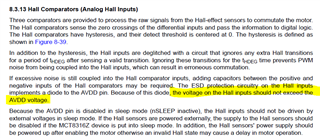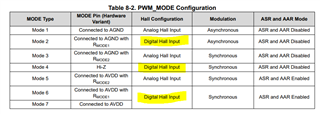Other Parts Discussed in Thread: MCT8316Z, ,
Hello, we are using the DRV8316 and MCT8316Z in our system and had the following questions
For the DRV8316, hall signals are coming from the motor to the microcontroller. We are thinking of adding a pull-up and a TVS diode. Would you also recommend adding a series resistor and small capacitor to improve filtering?
For the MCT8316Z, is any filtering needed on the halls at all? Also, what is the max IO voltage of the halls? Is 5V okay? The datasheet seems to be missing this information.




